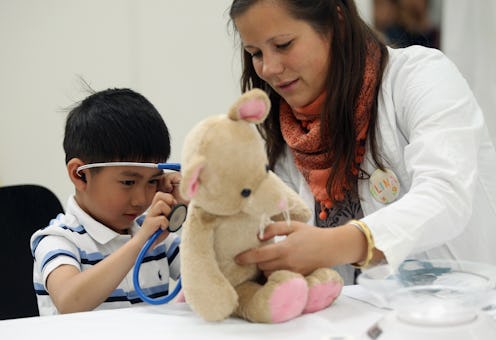When 12-year-old Gaby Zane heard from her mom Dr. Siobhan Murphy-Zane, an orthopedic surgeon, that stuffed animals weren't allowed in her hospital, she wondered if that rule could upset sick or injured children. After all, we've all been attached to some stuffed animal or other during our childhood; for Zane, it was her stuffed cat Sheena. So, for her fifth grade science project, she figured out a way to safely bring stuffed animals into hospitals without the risk of spreading bacteria — a scientific discovery that might seem small, but which might also make a big difference for a huge number of kids.
It turns out the solution was simple — just run the plush toys through the washer and drier and carry them to the hospital in a sealed plastic bag — but the means by which she arrived at that solution were not. Zane meticulously measured the bacteria on stuffed animals before and after washing and drying them, determining that cleaning "items of comfort" (the medical term) a day before bringing them to the hospital was sufficient to sterilize 79 percent of the stuffed animals she used.
Zane's science project evolved into the paper "Stuffed Animals in the Operating Room: A Reservoir of Bacteria With a Simple Solution," coauthored by Zane, her mom, and several colleagues and published in the Journal of Pediatric Orthopedics. Anyone in scientific research knows getting a study published is a highly competitive process regardless of age. This 12-year-old has accomplished what hundreds of grad students are vying for. Now, she just needs to figure out a way for me to bring my real cat into the hospital if I ever undergo an operation.
This isn't the first time a kid's science project has changed the world for the better, either. We can also thank the under-18 cohort for the following discoveries:
1. 10-Year-Old Kathryn Gray found a supernova.
Supernovas are notoriously elusive, but not to Gray, who was comparing a photo her dad took of the sky to earlier ones and noticed a difference. She suggested that she had identified a supernova, which eventually led to the Royal Astronomical Society confirming her discovery of Supernova 2010It from thousands of light years away.
2. 15-year-old Tony Hansberry created a stitching technique to make hysterectomies safer.
At the medically focused Darnell Cookman School in Jacksonville, Florida, Hansberry created a less invasive way of stitching up patients after hysterectomies, which at least one doctor has used since to minimize the risk of complications.
3. 14-year-old Suvir Mirchandani figured out a simple way to save the government millions.
By simply changing the font it used to type documents to Garamond, Mirchandani determined that that the U.S. federal and state governments could save $234 million annually on ink. Imagine where all that superfluous money could go.
4. 9-year-old Matthew Berger found a fossil pointing to a new human ancestor.
On a dig with his archaeologist father Professor Lee Berger, Matthew picked up a rock that contained a human-like collar bone. The team started digging at that site and found several more fossils that belonged to the previously undiscovered early hominid species Australopithecus sediba.
What do I have to say for my twice-as-long time here on Earth?
s
